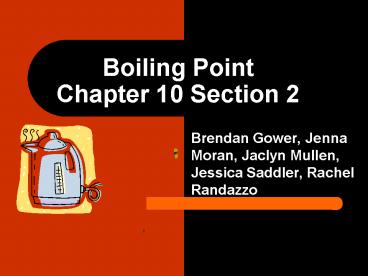Boiling Point Chapter 10 Section 2 - PowerPoint PPT Presentation
1 / 26
Title:
Boiling Point Chapter 10 Section 2
Description:
... 10 Section 2. Brendan Gower, Jenna Moran, Jaclyn Mullen, Jessica Saddler, Rachel Randazzo ... Intermolecular Forces ionic forces that occur as a result ... – PowerPoint PPT presentation
Number of Views:136
Avg rating:3.0/5.0
Title: Boiling Point Chapter 10 Section 2
1
Boiling PointChapter 10 Section 2
- Brendan Gower, Jenna Moran, Jaclyn Mullen,
Jessica Saddler, Rachel Randazzo
2
Points that we will cover
- Intermolecular Forces
- Kinetic Energy
- Boiling Point
- Vaporization
- Vapor Pressure
- Boiling as a cooling process
3
Intermolecular Forces
- Intermolecular Forces ionic forces that occur
as a result of opposite charges being attracted
to one another. - Liquid particles are attracted to one another by
intermolecular forces which refers to boiling
point.
4
Continued
- Liquid particles are polar, meaning the poles of
their molecules are oppositely charged and
attracted to one another. - This causes a liquid to have a unified, flowing
form.
5
Kinetic Energy
- Particles of a liquid that are constantly in
motion always have kinetic energy. - Kinetic energy energy of motion
- Non-heated liquid particles do not contain enough
kinetic energy to allow them to escape the liquid
as vapor.
6
Continued
- When heat is added to a liquid, kinetic energy is
added to the liquid particles. - This causes them to move more quickly.
- Heating also weakens the intermolecular forces
causing them to become less attracted to one
another.
7
Continued
- Heat and kinetic energy have a direct
relationship. - They increase and decrease together.
- More heatfaster moving particlesmore kinetic
energyhigher temperature
8
What is Boiling Point?
- Definition the temperature at which the vapor
pressure of the liquid is just equal to the
external pressure. - Normal boiling point the boiling point of a
liquid at a pressure of 101.3kPa (kilopascals-
the SI unit used to measure pressure) - Water 100C
9
Vaporization - the conversion of a liquid to a
gas or vapor.
- When a liquid reaches its boiling point, the
particles escape the liquid in the form of
bubbles of vapor (gas). - This occurs because the kinetic energy causes the
particles to move so fast that they actually
vaporize. - The gas bubbles are less dense than the liquid,
so thats why you see bubbles when you boil
something!
10
Vapor Pressure and External Pressure
- Definition - A force do to gas above the liquid.
- Pressure decrease boiling point/temperature
decrease - Pressure increase boiling point/temperature
increase - The external pressure (atmospheric pressure) must
be equal to the vapor pressure (a pressure
produced from the gas above the liquid).
11
(No Transcript)
12
At the boiling point, the vapor pressure is equal
to atmospheric pressure, bubbles form, and the
vaporization becomes a volume phenomena.
13
Examples
- Open books to page 278
- Sea Level at 70C liquid does not boil
- Sea Level 100C liquid boils
- Atop Mount Everest 70C liquid boils
- Chart of normal boiling points for common
substances
14
Boiling as a Cooling Process
- In a boiling liquid the particles with the
highest kinetic energy escape first. - The particles with the least kinetic energy are
left in the liquid state. - The leftover particles are moving slower and
therefore the temperature decreases.
15
Cooling Process
- Adding more heat to the liquid allows more
particles to vaporize, but the temperature cannot
rise above its boiling point. - If heat is supplied at a greater rate, the liquid
only boils faster.
16
- Lets take a look at the Boiling Process!
17
(No Transcript)
18
THE END!
19
Acknowledgements
- Wed like to thank ?
- Our moms for driving us to each others houses
- Mr. Edsall for teaching us about boiling point
and the movement of particles - Our group for helping to finish the project
- The class for listening and paying attention
20
Works Cited
- Wilbraham, Antony C., Dennis D. Staley, Michael
S. Matta, and Edward L. Waterman. Chemistry.
Needham, Upper Saddle River, Glenview Prentice
Hall, 2002. - Hyperphysics. August 2004. Georgia State
University Department of Physics and Astronomy.
30 January 2007. .edu/hbase/kinetic/vappre.html - Boiling. 30 January 2007. edu/gchelp/liquids/boil.html
- Vapor Pressure and Boiling Point. 2 February
2007. e_Boiling_Point.htm
21
Quiz
- 1. When temperature rises, the water particles
- a. Move faster b. Move slower c. stop moving
- 2. If vapor pressure decreases, what will happen
to the boiling point? - a. increase b. decrease c. stay the same
22
Quiz
- 3. What is energy of motion?
- a. Kinetic energy b. potential energy c. solar
energy - 4. What is the boiling point of water?
- a. 500C b. 100C c. 1234C
23
Quiz
- 5. What is the temperature at which the vapor
pressure of the liquid is just equal to the
external pressure? - a. Kinetic energy b. boiling point c. molecules
- True/False
- 6. ___ Water molecules are attracted to each
other.
24
Quiz
- 7. ___ Boiling is actually a cooling process.
- 8. ___ External pressure does not affect the
boiling point.
25
Quiz
- 9. The bubbles that form when a liquid is boiled
are - a. vapor bubbles b. smoke bubbles c. molecule
bubbles - 10. What is the conversion of a liquid to a gas
or vapor? - a. force b. heat c.
vaporization
26
Answers
- A
- B
- A
- B
- B
- 6. T
- 7. T
- 8. F
- 9. A
- 10.C






























